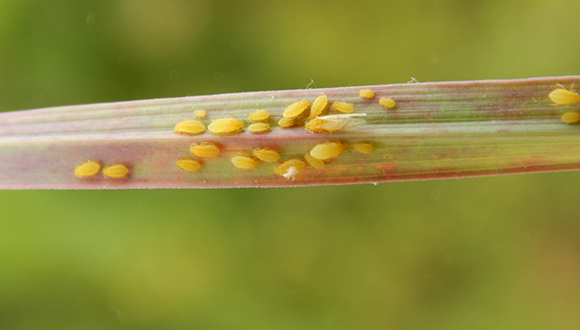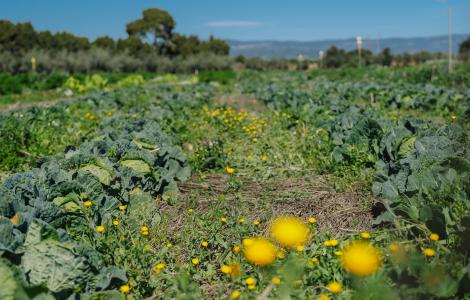Yellow sugarcane aphid detected in Spain
The yellow sugarcane aphid feeds on plants of the family of grasses. Researchers from the UAB and CREAF and from the University of León have discovered this species in Tarragona and Girona, which probably arrived from Northen Africa. Up to now it is unknown to what extent the aphid could represent a threat to European extensive crops of such plants, such as rice or maize, so it is needed a distribution map of this species in Europe in order to evaluate its potential pest behaviour.

Aphids are a kind of insects typically living on the aerial part of plants, feeding on the sap that flows through the phloem of plants with a specialized buccal apparatus. That is why they often behave as a pest in agricultural crops.
Recently, Carlos Hernández-Castellano, student of the MSc in Terrestrial Ecology at the UAB and research collaborator of the Centre for Ecological Research and Forestry Applications, and Nicolás Pérez Hidalgo, researcher from the University of León, discovered a new aphid species for the European Continent, in La Selva del Camp (province of Tarragona) and Blanes (province of Girona) (NE Spain).
Sipha flavais the latinized name of this species. Up to now it was known that this aphid was native to the Nearctic region (North America), although it has achieved to expand throughout Neartic region (South and Central America). In these regions Sipha flava is known as “the yellow sugarcane aphid”, and is an important pest of this crop, where it feeds on the plant and acts as a virus vector, together generating several symptoms in the plant ending up in yield reduction.
Is probable that this aphid has reached Continental Europe from the Southern Iberian Peninsula as a result of sugarcane crop expansion in northern Africa.
Is probable that this aphid has reached Continental Europe from the Southern Iberian Peninsula as a result of sugarcane crop expansion in northern Africa. Due to this crop is rather marginal in European Continent, Sipha flava is not expected to become a sugarcane pest in this zone. However, the oligophagous feeding habits of this aphid are well known, i.e. it feeds on several species from the same family, in this case grasses (Poaceae), and it is unknown to what extent the aphid could represent a threat to these kind of crops in Europe (e.g. rice or maize). Therefore it is needed a distribution map of this species in Europe in order to evaluate its potential pest behaviour, implementing the principle of precaution.
In addition to that, it was also discovered the first case in the whole Palaearctic region (Eurasia and North Africa) of an aphid feeding on a plant from the genus Hyparrhenia, and one of the first evidences that this aphid is attended by ants was also an important contribution (ants and aphids tend to establish mutualistic relationships, in which ants offer protection in exchange for honeydew excreted by the aphids).
This discover highlights the increasing threat of invasive species, a booming phenomenon caused by globalisation, leading not only to agricultural issues but raising as the second cause of biodiversity loss in the world, just after habitat destruction in importance.
This discover highlights the increasing threat of invasive species, a booming phenomenon caused by globalisation, leading not only to agricultural issues but raising as the second cause of biodiversity loss in the world, just after habitat destruction in importance. When a species is introduced into a non-original distribution area by human activities those species becomes exotic to the new territory. It can achieve establishment, forming viable populations by themselves (like Sipha flava did in the Iberian Peninsula), and will this species originate ecological or socioeconomical problems it would acquire invasive status.
Therefore, although the finding supposes an increase in the diversity knowledge of this aphid genera (to date just 10 species of this genus were known in Europe, and only 3 in the Iberian Peninsula), the alert message is clear.
This work was carried out in the context of Fauna Iberica Project, which aims to catalogue and to establish the distribution of the whole animal diversity in the Iberian Peninsula in order to guarantee its conservation.
ARTICLE
Carlos Hernández-Castellano, Nicolás Pérez Hidalgo. First Record of the Yellow Sugarcane Aphid Sipha Flava (Forbes) (Hemiptera Aphididae) in the European Continent. Redia, XCVII, 2014: 137-140.






